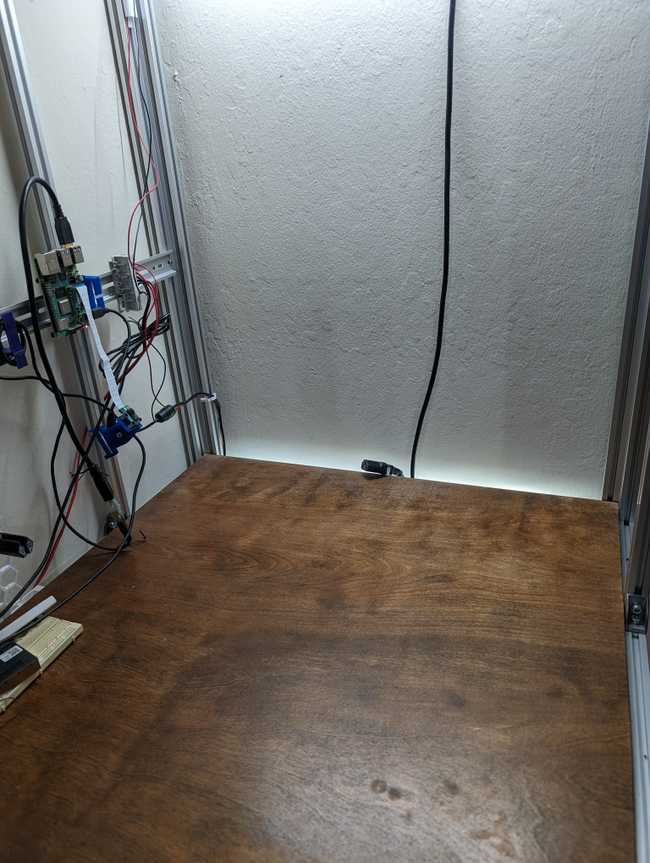I figured it was time to order my Trident because my Zero was starting to print reasonable and clean prints, except that I was in the middle of some projects that required a larger print bed. Remembering that the Zero took a while to show up, I put in the order and kinda forgot that I was getting it from the US warehouse and maybe I should keep a closer eye on the delivery date.
Thus, it was a few days into the week where I was not supposed to do lifting or housework.
Which meant that my spouse comes upstairs and tells me that she got the giant heavy box inside but if I wanted to get it upstairs, it could wait until I was better. And how big is this printer going to be anyways?
Which meant that this conversation happened:
The problem wasn’t that I was being difficult or trying to re-enact the meme, it’s just that I realized that I had hit the second frame of the meme and I couldn’t respond because I could see the meme in my mind’s eye.
Kit selection
There are three popular expansions of CBT. The first is Cognitive Behavioral Therapy, a well-regarded drug-free treatment methodology for conditions such as depression. The second is the one people often find when they search for the first and regret. The third is the MagicPhoenix CBT kits, where CBT means CanBus + Tap.
I was planning on getting a CBT kit but they are out of stock and if I look around the official Voron discord’s channel for them, it sounds like they have gone eerily silent. I’m not sold on the Tap, the CanBus seems like an upgrade, and the full 300mm Z axis would be really really nice.
The LDO kit has the full 300mm but it’s pricier and out-of-stock as well. There were some noises that there’s a new Trident on the way out but it sounds like it’s not a new Trident version, it’s just that LDO is making their kit fancier.
Thus, it looks like I might as well use the Formbot kit, and when I was ready to get the kit, the new “Pro” version arrived which has CanBus and Tap and some other bits and pieces… but not the 300mm Z-axis. Given that I kinda want to DOOMCUBE it, I can actually fix this down the road either by getting a set of the LDO steppers or by switching to a belted Z or deciding that 250mm on the Z axis is just fine.
The Voron discord is fairly negative about the high-flow Dragon but the standard-flow Dragon sounds fine. Mostly, I’m not printing speed-benchies here; what I want is good print quality but fast, where I can always add a CHT nozzle if I need more performance, so I’m leery about an overly high-flow hot-end. It feels most reasonable to have two identical hot-ends, at which point I can figure out what my performance limits look like and then upgrade then.
The Doom Tri
There’s the Trident-EZBake otherwise known as the “DOOMCUBE Trident”. Basically, replacing some of the 2020 extrusions with 4020 or 4040 extrusions. It’s a bit of a choose-your-own-adventure but the advantage of the is that you can insulate the printer better.
Presumably, at some point in the future, I’ll start in on a project where I do this, and at that point I’ll also address Z-height if I want.
Filter options
It feels like the goal is to be able to switch airflow setups and take advantage of having more room than a Zero. Obviously there needs to be some experimentation. But ABS likes a hot chamber and also it puts out a lot of VOCs so you want a configuration where there’s minimum outflow, basically just what is necessary to create negative pressure and/or prevent it from overheating. And then PLA wants a room-temperature chamber and it would be nice to have the airflow out be enough such that I don’t need to open the doors and lid. Which, obviously, might not actually be possible.
I figure a VOC sensor inside of the printer chassis is a requirement over time.
Some options for the Trident:
- Nevermore Micro - The V6 version is much improved over past revs, doesn’t require you to sing “CUT MY FAN INTO PIECES / THIS IS MY LAST RESORT” while building one. I have the mechanical bits for a Nevermore Micro in the box with the printer.
- THE FILTER - Positioned so as to better act as a bed fan than the Nevermore filters.
- Nevermore Mini - Adds a HEPA filter and more filter medium, better positioned so as to circulate air within the chamber.
- StealthMax - This one is interesting because of the exhaust slider and overall largeness.
- Voron HEPA exhaust filter
- BentoBox V2
The StealthMax is the most interesting because presumably with the exhaust slider, it’s most of the way there. Versus using an internal filter that’s just recirculating and then an external filtered exhaust that can be throttled and/or closed off.
Klipper + Docker + Ansible
My end-goal here is to apply a single Ansible role to both a Trident and a Zero such that both printers look and act alike and have the same klipper macros.
Given the Formbot kit just moved to a Manta, this also means I need a Pi compute module.
Other mods and odds
I suspect the Trident is going to end up with fewer added mods streamlined in than the Zero, especially because there’s not the same thing with preloading nuts.
Looking at the fans and where they are used, it looks like I might stick with the electronics compartment fans sized the same, just the quieter versions thereof, instead of doing a larger-scale skirt mod.
On the Voron discord the Trident Inverted Electronics mod was suggested as one of the few mods that you would want to do to a stock printer.
I probably want the Xol toolhead or maybe the DragonBurner on account of either one being lighter and with better cooling and there was discussion there that suggests that the best extruder for flexibles is the Vz-Hextrudort-Low but with the straight gears instead of the angled gears.
I kinda want to replace the Tap sensor with a Beacon now that it can work as both a radar sensor and a touch probe. At some point.
The Kinematic bed and the Monolithic Gantry sound like some other improvements.
I’ve already got a lot of the spare bits (screwdrivers, bearings, et al) and required tools.
Comparing the Formbot Trident printables folder against the stock
For a while, Formbot helpfully gave you a giant zip file containing “their” printable set. They applied their own organizational scheme which I guess might be helpful in some cases, but it’s also a bit of a hassle.
When I looked in, I found the files to be a mish-mash of stuff. There are files missing, where I’m not sure if that means that I don’t need them (for example, because it’s CANBus + Tap) or because somebody forgot, because the Formbot discord already contains examples of people finding missing files. And then there are some files that seem to match prior versions of the repo. So it feels like a mess. And Formbot took it down and promise to put up a GitHub repo shortly.
Paraphrasing what I wrote on their discord, the things you want to know are:
- What mechanical deviations from stock to expect - for example, the 3 to 6 board, the wiring’s a bit different, etc. This is already generally there in the ordering page, but it’s nice to have as an independent reference.
- What parts we shouldn’t print, either because they aren’t necessary or because they are replaced by one of the custom files.
- When given a choice between multiple parts (e.g. 2 hole or 3 hole chain link) which one to pick.
- Links to the required mods, where appropriate (this is in the PDF already, at least for the Trident).
- Presumably what git hash on the upstream the kit is built around (e.g. if they do a point release for the Trident files on git down the road, we know what the stable long-term reference is)
- A changelog of changes to kits sold under the same name (e.g. if the Trident Pro changes things, that would be a good call-out, but if you call it the Trident Super because it’s got some new fancy feature, that’s an obvious difference)
It’s obviously easier to store these on a git repo, especially if there’s multiple versions or bugfixes.
I can definitely appreciate that for the mods you might still want to package those because Printables is not really a git-style repository where you can provide a git hash.
I’d also suggest that it’s probably better to not fork the repo to create a customized repo unless you are intending to actually fork the printer.
cPIF
When I asked on the Formbot discord what to tell PIF providers, it was suggested that I explain what version of the kit I had. So I added that to the “special instructions” on the Formbot and crossed my fingers.
I think I got what I needed out of the commercial PIF program. I’ll find out as I go. Thankfully all of the important parts are designed to be printed on a V0, which I presently have.
It comes in bags with labels on the bags indicating what’s in the bag by filename, plus a mysterious unlabeled bag that’s all of the extra bits that I need. I was worried that I wasn’t getting the complete parts kit for a while before I compared the STL files against the parts in the unlabeled bag and realized that’s where the special Tap parts and everything lived.
I think the packing method is actually fine as compared to the way the Formbot printed parts kit for the zero came in a foam box, outside of shipping constraints, because I ended up sorting the Formbot parts for the zero into bags anyway.
Formbot Roll-in nuts
Apparently some folks have been having problems with the roll-in nuts provided with the kit. I will see what happens there.
It’s time to start
One of my tasks was to get the Ender 3v2 mostly back together and get all of my little spare parts and stuff specific to that printer bagged up for whoever I offload the printer to.

